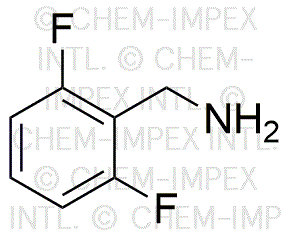2,6-Difluorobenzylamine is widely utilized in research focused on:
- Pharmaceutical Development: This compound serves as a key intermediate in the synthesis of various pharmaceuticals, particularly in the development of drugs targeting neurological and psychiatric disorders.
- Organic Synthesis: It is employed in organic synthesis as a building block for creating more complex molecules, allowing chemists to design and produce new compounds with desired properties.
- Material Science: The compound is used in the development of advanced materials, such as polymers and coatings, enhancing their chemical resistance and stability.
- Agricultural Chemicals: It plays a role in the formulation of agrochemicals, contributing to the development of more effective pesticides and herbicides that are crucial for crop protection.
- Research in Biochemistry: 2,6-Difluorobenzylamine is utilized in biochemical research to study enzyme interactions and metabolic pathways, providing insights into biological processes.
General Information
Properties
Safety and Regulations
Applications
2,6-Difluorobenzylamine is widely utilized in research focused on:
- Pharmaceutical Development: This compound serves as a key intermediate in the synthesis of various pharmaceuticals, particularly in the development of drugs targeting neurological and psychiatric disorders.
- Organic Synthesis: It is employed in organic synthesis as a building block for creating more complex molecules, allowing chemists to design and produce new compounds with desired properties.
- Material Science: The compound is used in the development of advanced materials, such as polymers and coatings, enhancing their chemical resistance and stability.
- Agricultural Chemicals: It plays a role in the formulation of agrochemicals, contributing to the development of more effective pesticides and herbicides that are crucial for crop protection.
- Research in Biochemistry: 2,6-Difluorobenzylamine is utilized in biochemical research to study enzyme interactions and metabolic pathways, providing insights into biological processes.
Documents
Safety Data Sheets (SDS)
The SDS provides comprehensive safety information on handling, storage, and disposal of the product.
Product Specification (PS)
The PS provides a comprehensive breakdown of the product’s properties, including chemical composition, physical state, purity, and storage requirements. It also details acceptable quality ranges and the product's intended applications.
Certificates of Analysis (COA)
Search for Certificates of Analysis (COA) by entering the products Lot Number. Lot and Batch Numbers can be found on a product’s label following the words ‘Lot’ or ‘Batch’.
Numéro de catalogue
Numéro de lot/série
Certificates Of Origin (COO)
This COO confirms the country where the product was manufactured, and also details the materials and components used in it and whether it is derived from natural, synthetic, or other specific sources. This certificate may be required for customs, trade, and regulatory compliance.
Numéro de catalogue
Numéro de lot/série
Safety Data Sheets (SDS)
The SDS provides comprehensive safety information on handling, storage, and disposal of the product.
DownloadProduct Specification (PS)
The PS provides a comprehensive breakdown of the product’s properties, including chemical composition, physical state, purity, and storage requirements. It also details acceptable quality ranges and the product's intended applications.
DownloadCertificates of Analysis (COA)
Search for Certificates of Analysis (COA) by entering the products Lot Number. Lot and Batch Numbers can be found on a product’s label following the words ‘Lot’ or ‘Batch’.
Numéro de catalogue
Numéro de lot/série
Certificates Of Origin (COO)
This COO confirms the country where the product was manufactured, and also details the materials and components used in it and whether it is derived from natural, synthetic, or other specific sources. This certificate may be required for customs, trade, and regulatory compliance.


